door lock BMW 540I 2000 E39 Central Body Electronics ZKE Manual
[x] Cancel search | Manufacturer: BMW, Model Year: 2000, Model line: 540i, Model: BMW 540i 2000 E39Pages: 80, PDF Size: 4.14 MB
Page 3 of 80
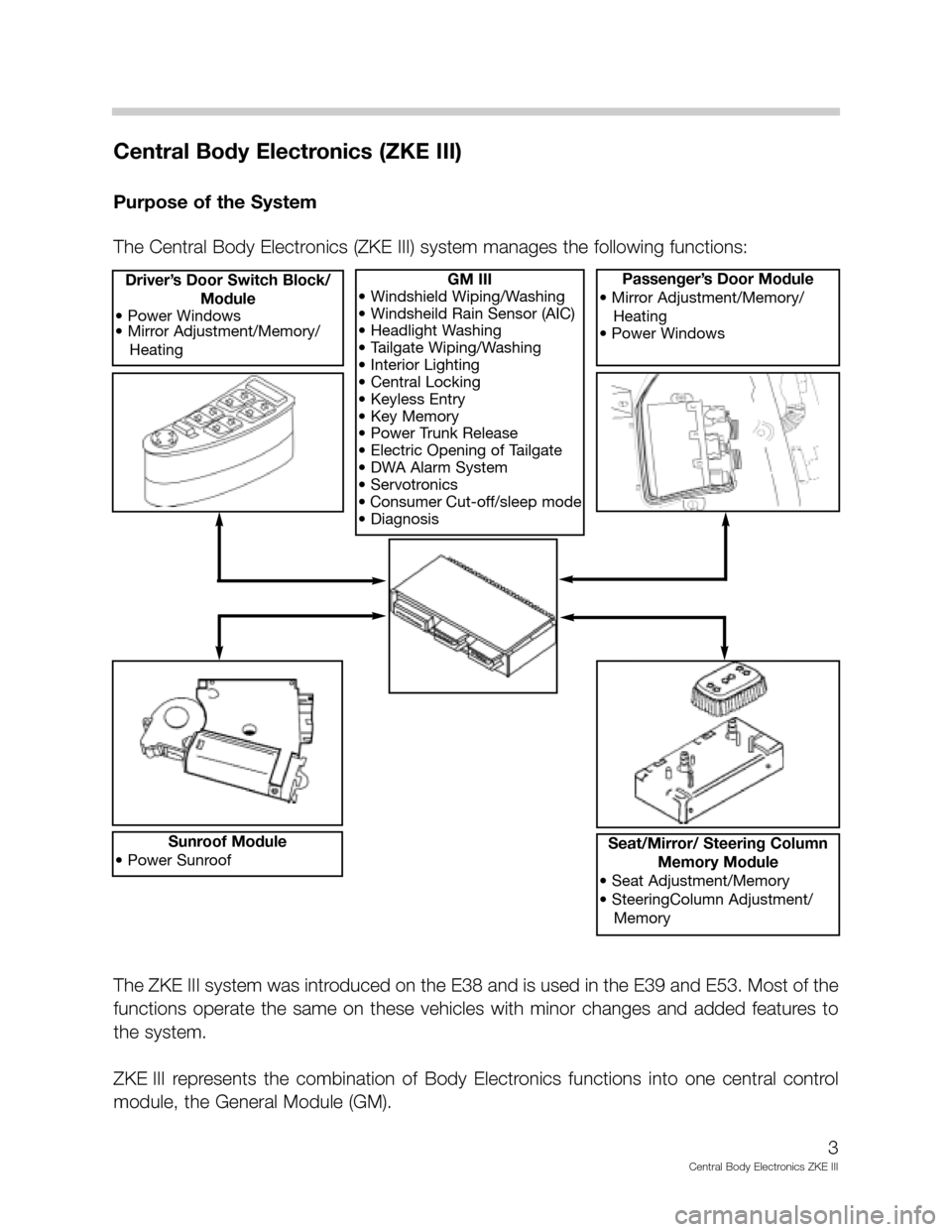
3
Central Body Electronics ZKE III
Central Body Electronics (ZKE III)
Purpose of the System
The Central Body Electronics (ZKE III) system manages the following functions:
GM III
• Windshield Wiping/Washing
• Windsheild Rain Sensor (AIC)
• Headlight Washing
• Tailgate Wiping/Washing
• Interior Lighting
• Central Locking
• Keyless Entry
• Key Memory
• Power Trunk Release
• Electric Opening of Tailgate
• DWA Alarm System
• Servotronics
• Consumer Cut-off/sleep mode
• DiagnosisDriver’s Door Switch Block/
Module
• Power Windows
• Mirror Adjustment/Memory/
HeatingPassenger’s Door Module
• Mirror Adjustment/Memory/
Heating
• Power Windows
Sunroof Module
• Power SunroofSeat/Mirror/ Steering Column
Memory Module
• Seat Adjustment/Memory
• SteeringColumn Adjustment/
Memory
The ZKE III system was introduced on the E38 and is used in the E39 and E53. Most of the
functions operate the same on these vehicles with minor changes and added features to
the system.
ZKE III represents the combination of Body Electronics functions into one central control
module, the General Module (GM).
Page 5 of 80
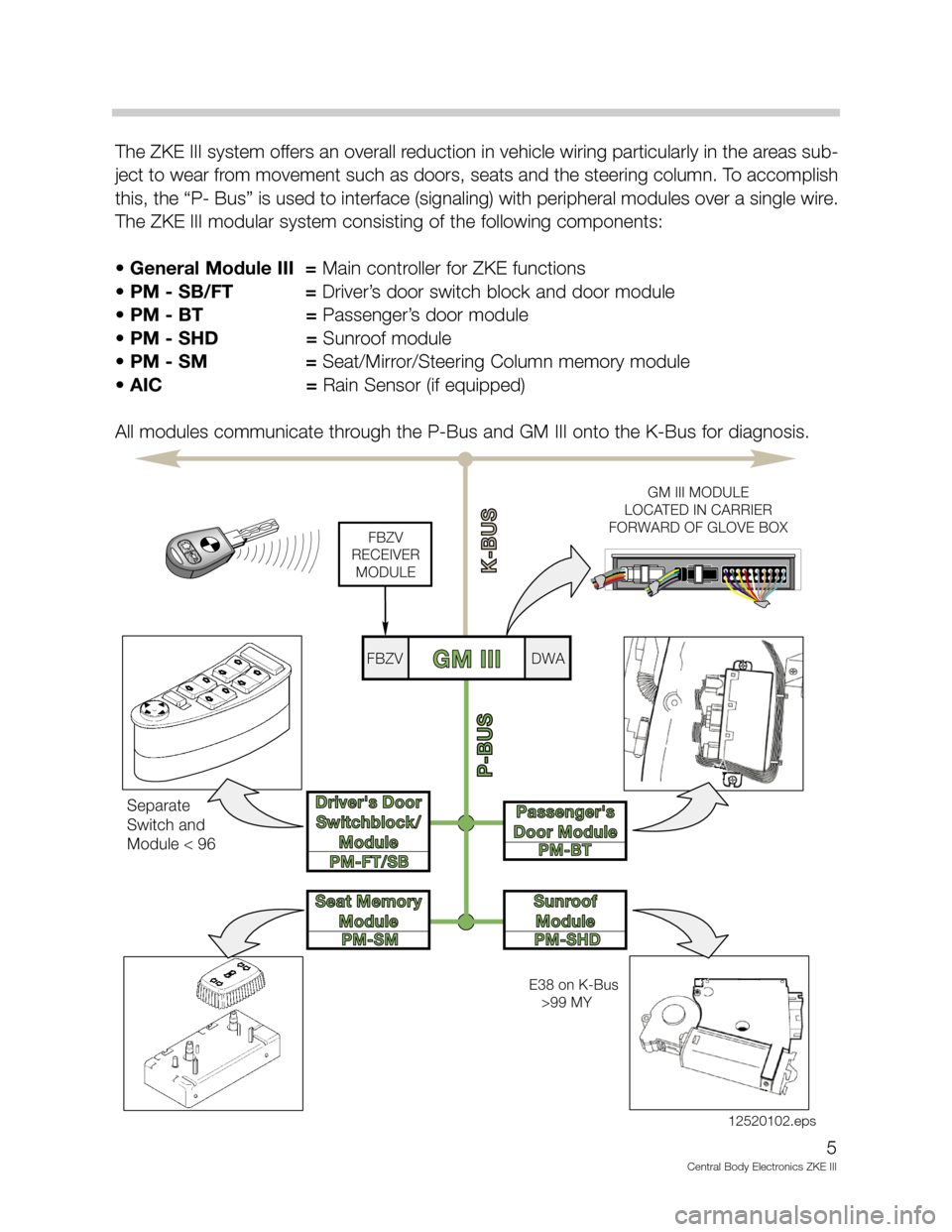
5
Central Body Electronics ZKE III
The ZKE III system offers an overall reduction in vehicle wiring particularly in the areas sub-
ject to wear from movement such as doors, seats and the steering column. To accomplish
this, the “P- Bus” is used to interface (signaling) with peripheral modules over a single wire.
The ZKE III modular system consisting of the following components:
• General Module III = Main controller for ZKE functions
• PM - SB/FT = Driver’s door switch block and door module
• PM - BT = Passenger’s door module
• PM - SHD =Sunroof module
•PM - SM =Seat/Mirror/Steering Column memory module
• AIC = Rain Sensor (if equipped)
All modules communicate through the P-Bus and GM III onto the K-Bus for diagnosis.
PM-FT/SB
PM-SMPM-BT
PM-SHD
P-BUS
K-BUS
Driver's Door
Switchblock/
ModuleDriver's Door
Switchblock/
Module
Seat Memory
ModuleSeat Memory
Module
Passenger's
Door ModulePassenger's
Door Module
Sunroof
ModuleSunroof
Module
GM IIIFBZVFBZVDWADWA
FBZV
RECEIVER
MODULE
GM III MODULE
LOCATED IN CARRIER
FORWARD OF GLOVE BOX
Separate
Switch and
Module < 96
E38 on K-Bus
>99 MY
12520102.eps
Page 6 of 80
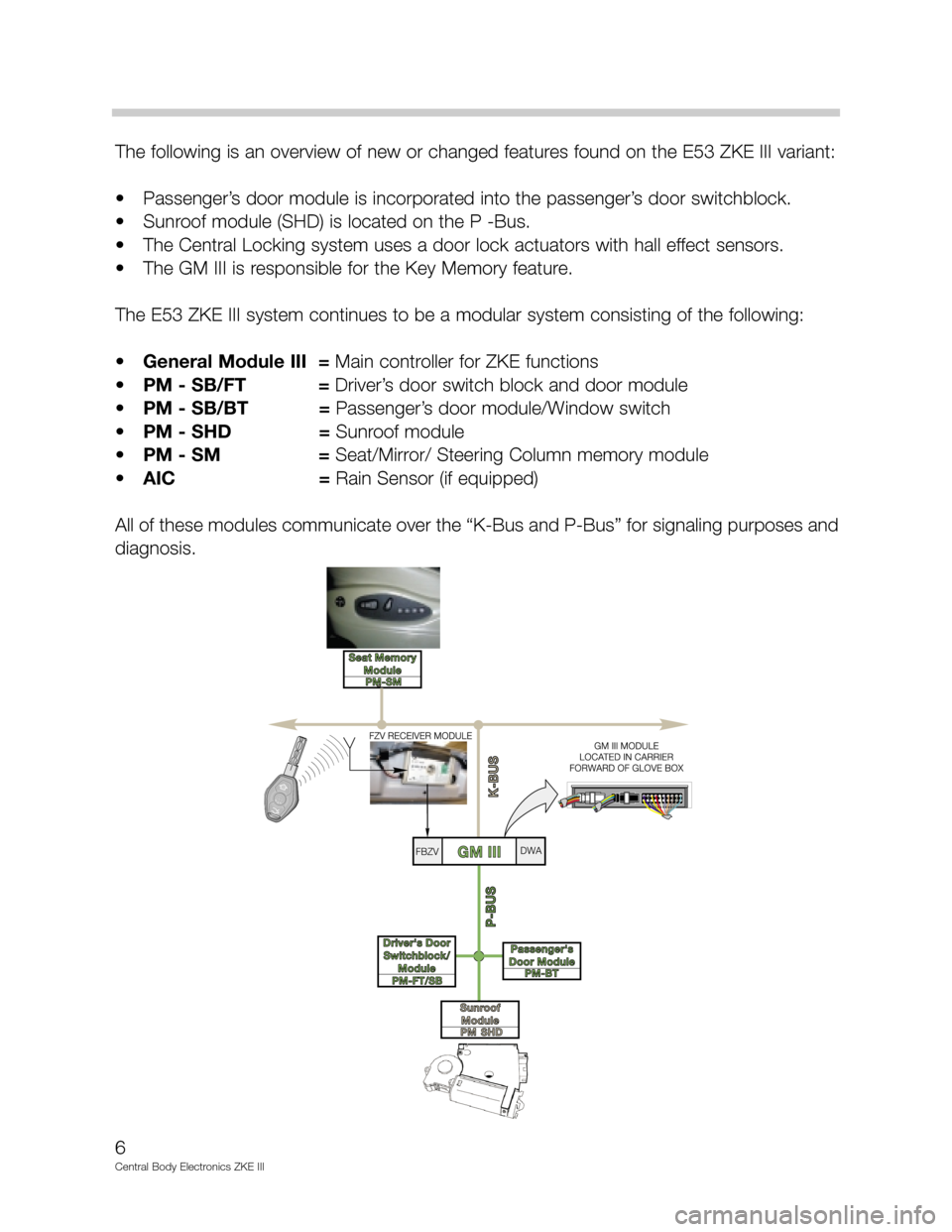
6
Central Body Electronics ZKE III
The following is an overview of new or changed features found on the E53 ZKE III variant:
• Passenger’s door module is incorporated into the passenger’s door switchblock.
• Sunroof module (SHD) is located on the P -Bus.
• The Central Locking system uses a door lock actuators with hall effect sensors.
• The GM III is responsible for the Key Memory feature.
The E53 ZKE III system continues to be a modular system consisting of the following:
•General Module III = Main controller for ZKE functions
•PM - SB/FT = Driver’s door switch block and door module
•PM - SB/BT =Passenger’s door module/Window switch
•PM - SHD =Sunroof module
•PM - SM =Seat/Mirror/ Steering Column memory module
•AIC = Rain Sensor (if equipped)
All of these modules communicate over the “K-Bus and P-Bus” for signaling purposes and
diagnosis.
Page 17 of 80
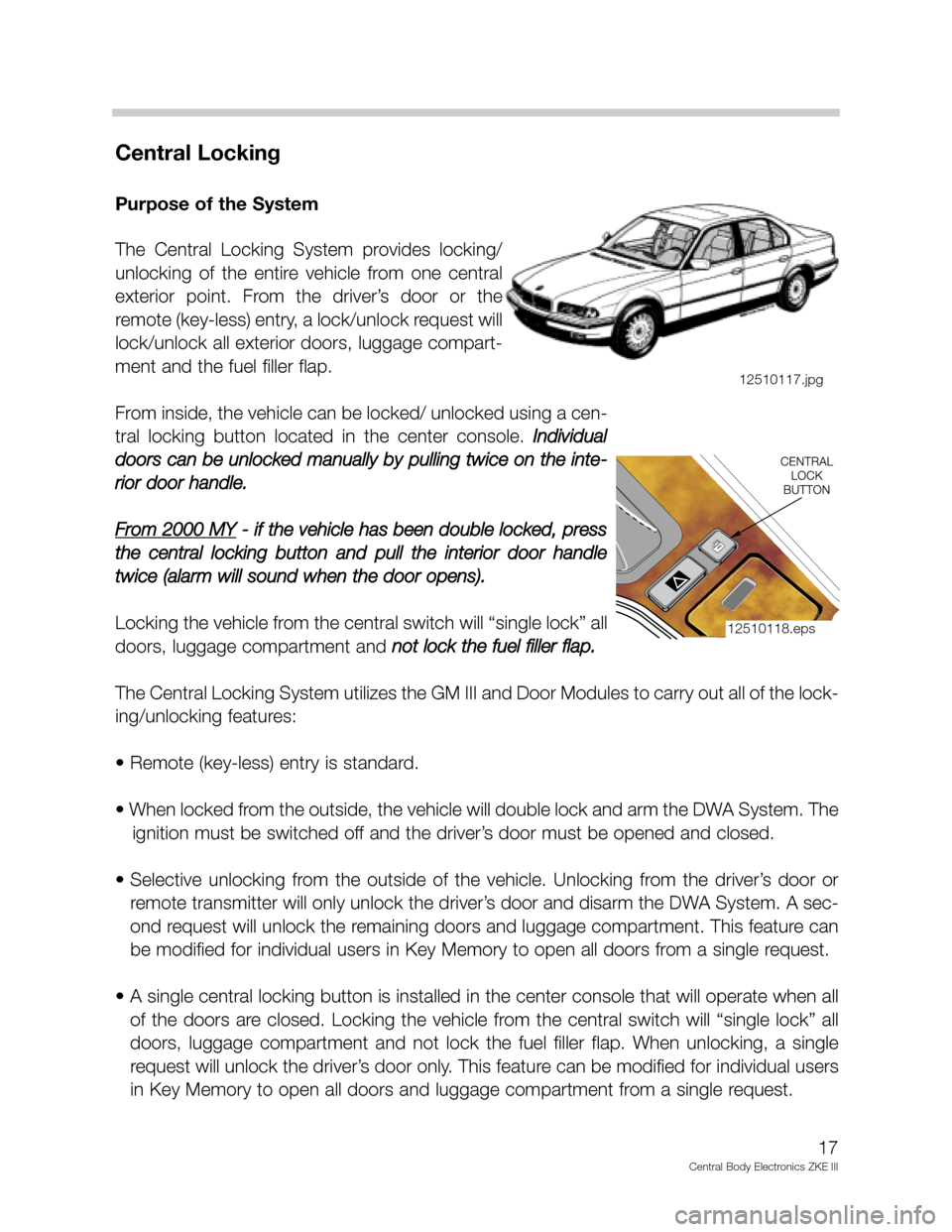
Central Locking
Purpose of the System
The Central Locking System provides locking/
unlocking of the entire vehicle from one central
exterior point. From the driver’s door or the
remote (key-less) entry, a lock/unlock request will
lock/unlock all exterior doors, luggage compart-
ment and the fuel filler flap.
From inside, the vehicle can be locked/ unlocked using a cen-
tral locking button located in the center console. Individual
doors can be unlocked manually by pulling twice on the inte-
rior door handle.
From 2000 MY
- if the vehicle has been double locked, press
the central locking button and pull the interior door handle
twice (alarm will sound when the door opens).
Locking the vehicle from the central switch will “single lock” all
doors, luggage compartment and not lock the fuel filler flap.
The Central Locking System utilizes the GM III and Door Modules to carry out all of the lock-
ing/unlocking features:
• Remote (key-less) entry is standard.
• When locked from the outside, the vehicle will double lock and arm the DWA System. The
ignition must be switched off and the driver’s door must be opened and closed.
• Selective unlocking from the outside of the vehicle. Unlocking from the driver’s door or
remote transmitter will only unlock the driver’s door and disarm the DWA System. A sec-
ond request will unlock the remaining doors and luggage compartment. This feature can
be modified for individual users in Key Memory to open all doors from a single request.
• A single central locking button is installed in the center console that will operate when all
of the doors are closed. Locking the vehicle from the central switch will “single lock” all
doors, luggage compartment and not lock the fuel filler flap. When unlocking, a single
request will unlock the driver’s door only. This feature can be modified for individual users
in Key Memory to open all doors and luggage compartment from a single request.
17
Central Body Electronics ZKE III
12510117.jpg
12510118.eps
Page 18 of 80
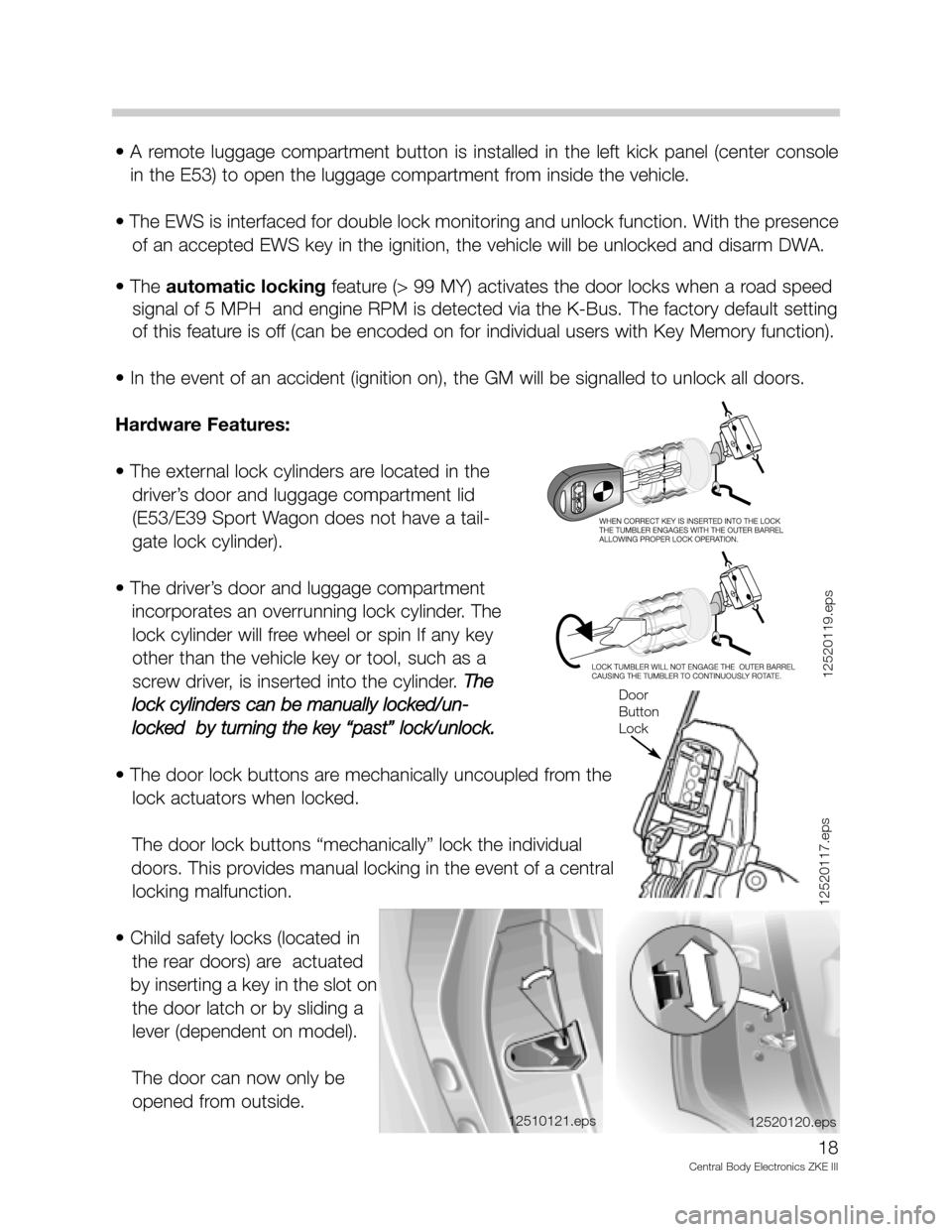
• A remote luggage compartment button is installed in the left kick panel (center console
in the E53) to open the luggage compartment from inside the vehicle.
• The EWS is interfaced for double lock monitoring and unlock function. With the presence
of an accepted EWS key in the ignition, the vehicle will be unlocked and disarm DWA.
• The automatic locking feature (> 99 MY) activates the door locks when a road speed
signal of 5 MPH and engine RPM is detected via the K-Bus. The factory default setting
of this feature is off (can be encoded on for individual users with Key Memory function).
• In the event of an accident (ignition on), the GM will be signalled to unlock all doors.
Hardware Features:
• The external lock cylinders are located in the
driver’s door and luggage compartment lid
(E53/E39 Sport Wagon does not have a tail-
gate lock cylinder).
• The driver’s door and luggage compartment
incorporates an overrunning lock cylinder. The
lock cylinder will free wheel or spin If any key
other than the vehicle key or tool, such as a
screw driver, is inserted into the cylinder. The
lock cylinders can be manually locked/un-
locked by turning the key “past” lock/unlock.
• The door lock buttons are mechanically uncoupled from the
lock actuators when locked.
The door lock buttons “mechanically” lock the individual
doors. This provides manual locking in the event of a central
locking malfunction.
• Child safety locks (located in
the rear doors) are actuated
by inserting a key in the slot on
the door latch or by sliding a
lever (dependent on model).
The door can now only be
opened from outside.
18
Central Body Electronics ZKE III
Door
Button
Lock
12520117.eps
12520119.eps
12510121.eps
12520120.eps
Page 20 of 80
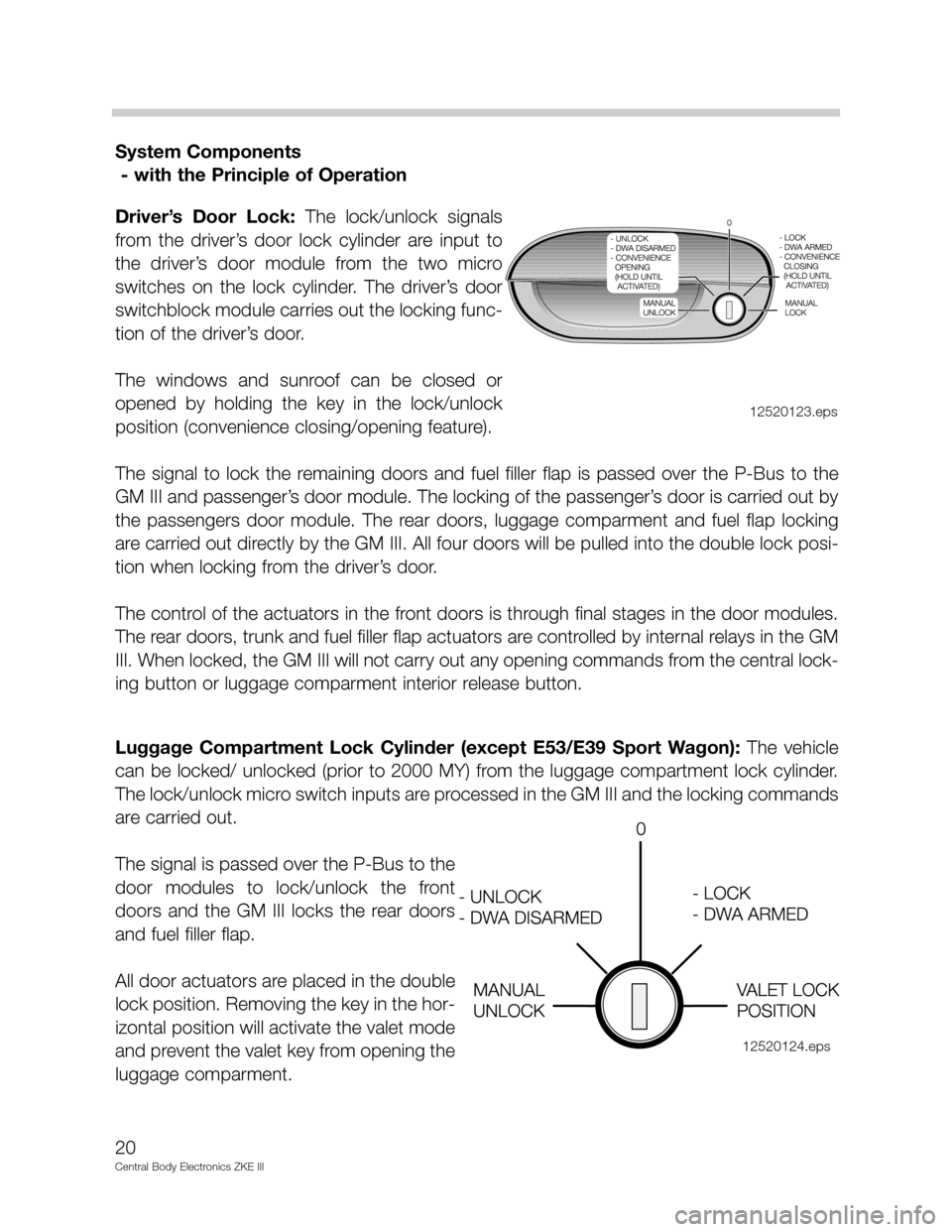
System Components
- with the Principle of Operation
Driver’s Door Lock: The lock/unlock signals
from the driver’s door lock cylinder are input to
the driver’s door module from the two micro
switches on the lock cylinder. The driver’s door
switchblock module carries out the locking func-
tion of the driver’s door.
The windows and sunroof can be closed or
opened by holding the key in the lock/unlock
position (convenience closing/opening feature).
The signal to lock the remaining doors and fuel filler flap is passed over the P-Bus to the
GM III and passenger’s door module. The locking of the passenger’s door is carried out by
the passengers door module. The rear doors, luggage comparment and fuel flap locking
are carried out directly by the GM III. All four doors will be pulled into the double lock posi-
tion when locking from the driver’s door.
The control of the actuators in the front doors is through final stages in the door modules.
The rear doors, trunk and fuel filler flap actuators are controlled by internal relays in the GM
III. When locked, the GM III will not carry out any opening commands from the central lock-
ing button or luggage comparment interior release button.
Luggage Compartment Lock Cylinder (except E53/E39 Sport Wagon): The vehicle
can be locked/ unlocked (prior to 2000 MY) from the luggage compartment lock cylinder.
The lock/unlock micro switch inputs are processed in the GM III and the locking commands
are carried out.
The signal is passed over the P-Bus to the
door modules to lock/unlock the front
doors and the GM III locks the rear doors
and fuel filler flap.
All door actuators are placed in the double
lock position. Removing the key in the hor-
izontal position will activate the valet mode
and prevent the valet key from opening the
luggage comparment.
20
Central Body Electronics ZKE III
12520123.eps
12520124.eps
Page 21 of 80
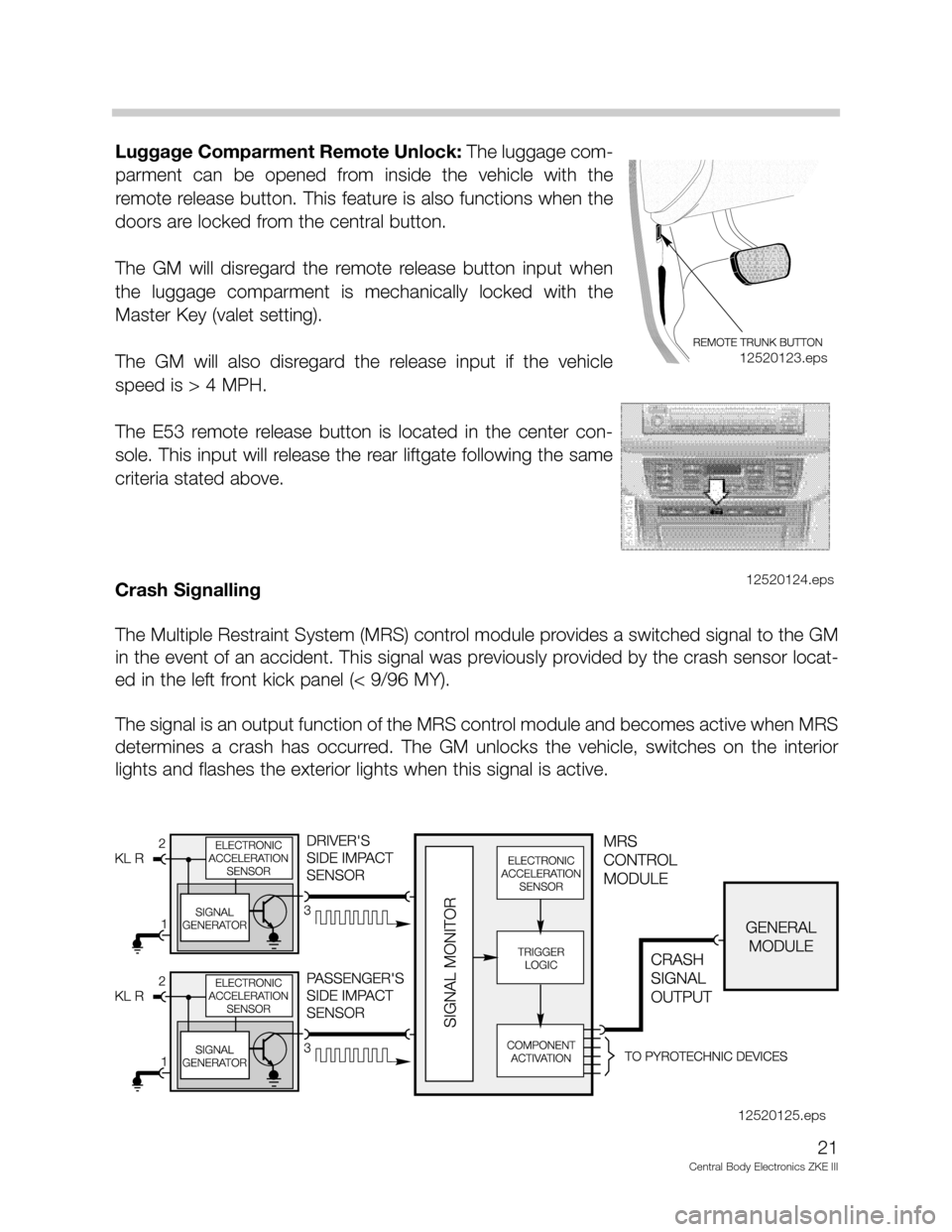
Luggage Comparment Remote Unlock: The luggage com-
parment can be opened from inside the vehicle with the
remote release button. This feature is also functions when the
doors are locked from the central button.
The GM will disregard the remote release button input when
the luggage comparment is mechanically locked with the
Master Key (valet setting).
The GM will also disregard the release input if the vehicle
speed is > 4 MPH.
The E53 remote release button is located in the center con-
sole. This input will release the rear liftgate following the same
criteria stated above.
Crash Signalling
The Multiple Restraint System (MRS) control module provides a switched signal to the GM
in the event of an accident. This signal was previously provided by the crash sensor locat-
ed in the left front kick panel (< 9/96 MY).
The signal is an output function of the MRS control module and becomes active when MRS
determines a crash has occurred. The GM unlocks the vehicle, switches on the interior
lights and flashes the exterior lights when this signal is active.
21
Central Body Electronics ZKE III
12520123.eps
12520124.eps
12520125.eps
Page 23 of 80
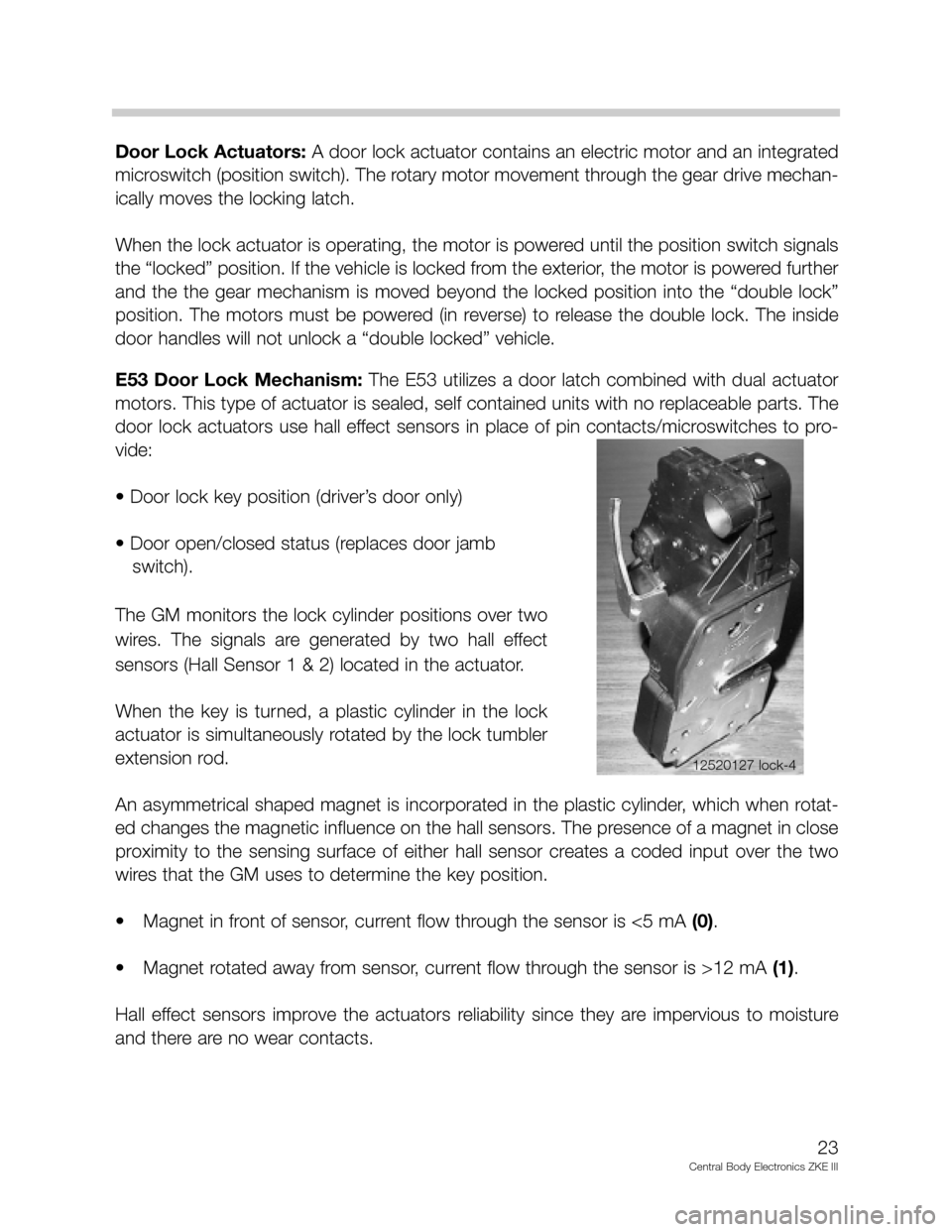
Door Lock Actuators: A door lock actuator contains an electric motor and an integrated
microswitch (position switch). The rotary motor movement through the gear drive mechan-
ically moves the locking latch.
When the lock actuator is operating, the motor is powered until the position switch signals
the “locked” position. If the vehicle is locked from the exterior, the motor is powered further
and the the gear mechanism is moved beyond the locked position into the “double lock”
position. The motors must be powered (in reverse) to release the double lock. The inside
door handles will not unlock a “double locked” vehicle.
E53 Door Lock Mechanism: The E53 utilizes a door latch combined with dual actuator
motors. This type of actuator is sealed, self contained units with no replaceable parts. The
door lock actuators use hall effect sensors in place of pin contacts/microswitches to pro-
vide:
• Door lock key position (driver’s door only)
• Door open/closed status (replaces door jamb
switch).
The GM monitors the lock cylinder positions over two
wires. The signals are generated by two hall effect
sensors (Hall Sensor 1 & 2) located in the actuator.
When the key is turned, a plastic cylinder in the lock
actuator is simultaneously rotated by the lock tumbler
extension rod.
An asymmetrical shaped magnet is incorporated in the plastic cylinder, which when rotat-
ed changes the magnetic influence on the hall sensors. The presence of a magnet in close
proximity to the sensing surface of either hall sensor creates a coded input over the two
wires that the GM uses to determine the key position.
• Magnet in front of sensor, current flow through the sensor is <5 mA (0).
• Magnet rotated away from sensor, current flow through the sensor is >12 mA (1).
Hall effect sensors improve the actuators reliability since they are impervious to moisture
and there are no wear contacts.
23
Central Body Electronics ZKE III
12520127 lock-4
Page 24 of 80
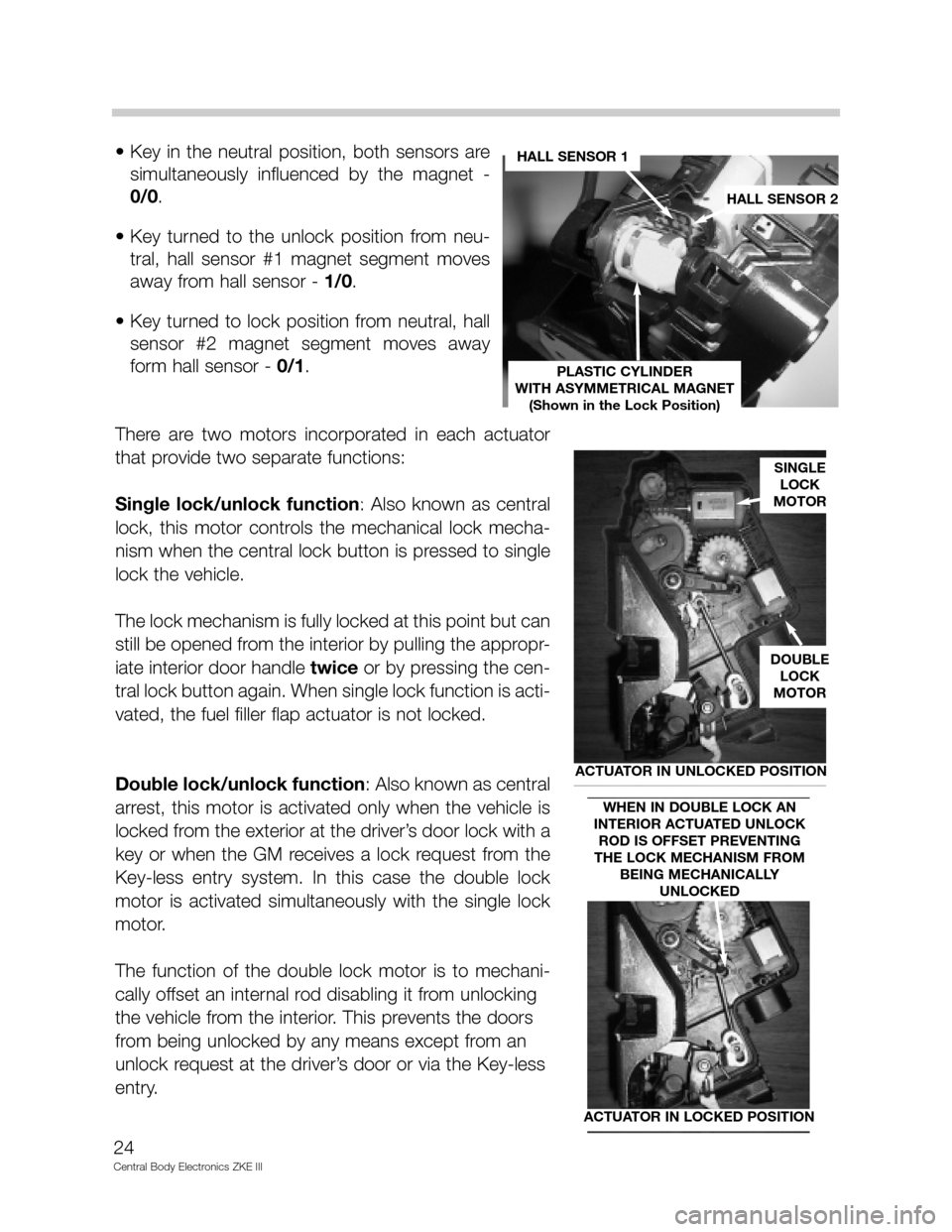
• Key in the neutral position, both sensors are
simultaneously influenced by the magnet -
0/0.
• Key turned to the unlock position from neu-
tral, hall sensor #1 magnet segment moves
away from hall sensor - 1/0.
• Key turned to lock position from neutral, hall
sensor #2 magnet segment moves away
form hall sensor - 0/1.
There are two motors incorporated in each actuator
that provide two separate functions:
Single lock/unlock function: Also known as central
lock, this motor controls the mechanical lock mecha-
nism when the central lock button is pressed to single
lock the vehicle.
The lock mechanism is fully locked at this point but can
still be opened from the interior by pulling the appropr-
iate interior door handle twice or by pressing the cen-
tral lock button again. When single lock function is acti-
vated, the fuel filler flap actuator is not locked.
Double lock/unlock function: Also known as central
arrest, this motor is activated only when the vehicle is
locked from the exterior at the driver’s door lock with a
key or when the GM receives a lock request from the
Key-less entry system. In this case the double lock
motor is activated simultaneously with the single lock
motor.
The function of the double lock motor is to mechani-
cally offset an internal rod disabling it from unlocking
the vehicle from the interior. This prevents the doors
from being unlocked by any means except from an
unlock request at the driver’s door or via the Key-less
entry.
24
Central Body Electronics ZKE III
HALL SENSOR 1
HALL SENSOR 2
PLASTIC CYLINDER
WITH ASYMMETRICAL MAGNET
(Shown in the Lock Position)
SINGLE
LOCK
MOTOR
DOUBLE
LOCK
MOTOR
ACTUATOR IN UNLOCKED POSITION
ACTUATOR IN LOCKED POSITION
WHEN IN DOUBLE LOCK AN
INTERIOR ACTUATED UNLOCK
ROD IS OFFSET PREVENTING
THE LOCK MECHANISM FROM
BEING MECHANICALLY
UNLOCKED
Page 25 of 80
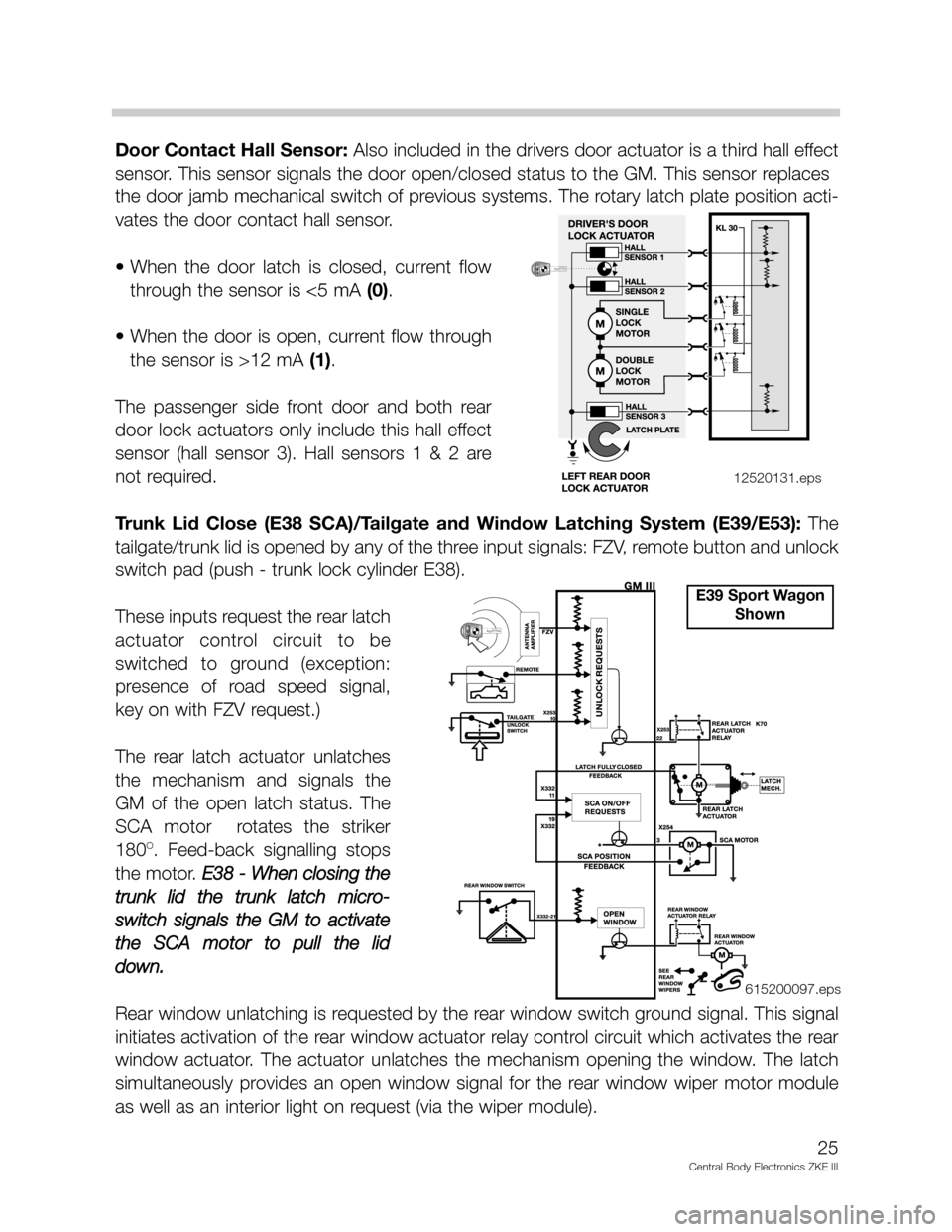
Door Contact Hall Sensor: Also included in the drivers door actuator is a third hall effect
sensor. This sensor signals the door open/closed status to the GM. This sensor replaces
the door jamb mechanical switch of previous systems. The rotary latch plate position acti-
vates the door contact hall sensor.
• When the door latch is closed, current flow
through the sensor is <5 mA (0).
• When the door is open, current flow through
the sensor is >12 mA (1).
The passenger side front door and both rear
door lock actuators only include this hall effect
sensor (hall sensor 3). Hall sensors 1 & 2 are
not required.
Trunk Lid Close (E38 SCA)/Tailgate and Window Latching System (E39/E53): The
tailgate/trunk lid is opened by any of the three input signals: FZV, remote button and unlock
switch pad (push - trunk lock cylinder E38).
These inputs request the rear latch
actuator control circuit to be
switched to ground (exception:
presence of road speed signal,
key on with FZV request.)
The rear latch actuator unlatches
the mechanism and signals the
GM of the open latch status. The
SCA motor rotates the striker
180
O. Feed-back signalling stops
the motor. E38 - When closing the
trunk lid the trunk latch micro-
switch signals the GM to activate
the SCA motor to pull the lid
down.
Rear window unlatching is requested by the rear window switch ground signal. This signal
initiates activation of the rear window actuator relay control circuit which activates the rear
window actuator. The actuator unlatches the mechanism opening the window. The latch
simultaneously provides an open window signal for the rear window wiper motor module
as well as an interior light on request (via the wiper module).
25
Central Body Electronics ZKE III
12520131.eps
E39 Sport Wagon
Shown
615200097.eps